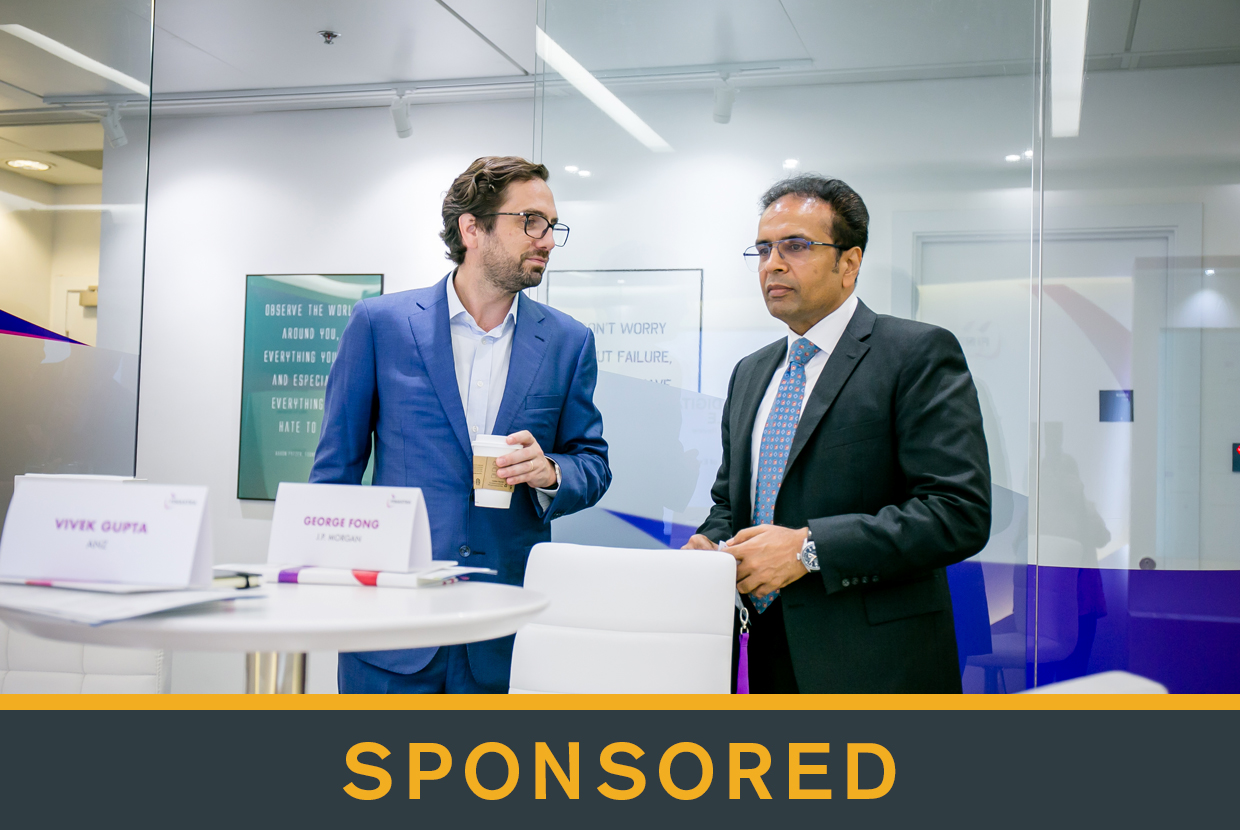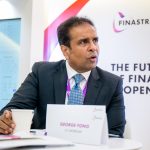As fintech initiatives continue to revolutionise the trade finance industry, a group of experts gathered at the city’s Cyberport to discuss the main developments in Hong Kong.
Roundtable participants
- Finbarr Bermingham, Asia editor, GTR (chair)
- Andrew Coles, head of banking solutions, Asia Pacific, Finastra
- George Fong, head of trade product management, Asia Pacific, JP Morgan
- Vivek Gupta, head of trade and supply chain, North Asia and Greater China, ANZ
- P Venkatraman, global product owner for documentary trade products, HSBC
GTR: What are the fintech initiatives that are exciting people in the industry in Hong Kong?
Gupta: While there have been a number of efforts which have been piloted in our industry, the real challenge has been how to stitch together a solution that from the client perspective takes care of a whole bunch of issues, from digitising bills of lading, to having a single window for the customs side, to really having the regulator look at data-driven decision-making, and most importantly for the underlying infrastructure technology perspective.
The two main government sector sponsored initiatives – the Networked Trade Platform (NTP) in Singapore and the eTradeConnect government-run platform in Hong Kong – have moved fairly quickly. They are addressing slightly different needs. The NTP is addressing trade, whereas eTradeConnect is focused on trade finance. These are bank-led and government-led, but the proof of the pudding is how quickly do you move something from proof of concept to production. We are very pleased with the pace at which the Hong Kong platform has moved in 15 months. Clearly, much more needs to be done, but I think it has all the right ingredients with the strong regulatory sponsorship to make it work.
GTR: In terms of general progress, how do you assess what’s happening in the industry?
Venkatraman: There is a lot of action, and we have always known that we can’t be doing these island solutions. While it has to start small, what is required at the end of the day is the scale and the creation of a standardised model. If I go back three years, it was always a concern of saying, ‘we need the regulators and the shipping companies to be in’. We are seeing various pieces now coming together. The regulators are interested, the shipping companies are doing their bit. I think the next stage has to be things coming together.
Fong: As we all know, digitisation in trade has been around since the 1980s, and if you fast forward to now, it has been multiple solutions around trying to digitise the whole ecosystem of trade. Most of those have not succeeded. Even those that have fared a bit better have ended up as a niche player as opposed to having the whole ecosystem connected together.
There are a couple of things we need to consider. We need to understand what the client needs. A lot of the initiatives have been put in place by the bank without the voice of the clients, and that has been a challenge in terms of making it work. That is something that is still a sentiment among clients, and that is why there is still that lack of pick-up. A lot of clients are looking to see how this all develops.
The approach taken by the Hong Kong Monetary Authority (HKMA), where it is putting focus groups together to try and understand what the corporate client needs is definitely the right direction.
The other thing is around the digital islands that we have now: how do you connect them more without saying, ‘it’s my way or the highway’? The whole interoperability issue is something that needs to be worked out. But it is not something that is going to happen in the short term. The digitisation of trade is going to take more time than we think it will need.
GTR: You mentioned previous efforts of digitisation which were all very well-intentioned, and they seemed to just die a death. Was that because banks did not involve clients? Are banks now bearing the lessons of the past in mind?
Fong: I feel that many banks are now taking that approach. The fact that you are looking at focus groups with clients whenever they roll out a proprietary platform, that is definitely a recognition that it has to be driven from the clients’ perspective as opposed to what the bank feels is the right thing to do. That connectivity is there. But again, that is only part of the puzzle to make this work.
Gupta: I have a slightly different perspective on that. I think it wasn’t that the bank payment obligation (BPO) was developed in isolation from the client or that the clients’ needs weren’t well articulated. The real challenge was that it required banks to effectively collaborate with each other. And the success of BPO scalability was contingent on banks convincing their customers. I think that’s where the traction was lost.
That is why, in my view, the eTradeConnect model is working: you have a fairly progressive regulator which has had these conversations and seen what needs to be done, and this is influencing banks to drive traction.
Coles: We do a lot of market research at Finastra, particularly in the corporate banking space. One of the statistics that has stuck out is that about 70% of corporates are choosing their banking relationships now based on digital capabilities. The workforce that is coming through is young, they are tech savvy, they are tech native; they expect that same level of digitisation and sophistication in their corporate banking business as they have in the retail banking business. If you are not providing this digital capability, if you are still insisting on manual and paper-based processes, then they will start looking elsewhere, and they will be more likely to shift their business to somebody who can actually provide that kind of service.
GTR: Do you fear that there is a fintech company that could take your business away from you if you are not performing to the right level?
Venkatraman: Absolutely. The way banks used to handle transformation or digital change was quite different before. It used to be a kind of one step, pick a project out. Today we have a methodology which is trying to change step-by-step, bit-by-bit. That has made the whole journey very different, and people are ready to accept pieces of change while they have an end goal. We know what we want to do with the customers, we know there are external factors impacting it, from regulators to insurance companies, bills of lading, shippers, but we know you have to move the bits so that at some point it all comes together.
Gupta: In the past there was a very strong tendency of us versus them, banks versus non-banks. The whole focus around competition is very clearly demonstrated: we now need to move and quicker than is happening on collaboration and co-creation. This change is not specific to trade. In trade and cash and retail and security services, this focus on digitisation is sweeping the banking industry at large.
GTR: How do you think Hong Kong compares to Singapore, particularly with regard to trade finance digitisation?
Coles: There is a great regional rivalry, that pushes both to improve and move forward. I think rivalry is a good thing. Even though we are headquartered for Asia in Singapore, and with our new premises in Cyberport, we’ve also got our bets into Hong Kong. The proximity to China is obviously a huge factor at play here, as is that access into the Chinese market that you get from the Hong Kong banks.
The trade finance space to me is so exciting right now. I started off in trade finance, and it used to be the business that was run out of the basement and there was no kind of investment on the technology, it was all reams of paper held in folders. The interest in this particular area of business at the moment is phenomenal. There are so many companies looking at particular use cases, problem statements, and at leveraging technology.
We have OCR scanning of shipping documents, allowing us to digitise those shipping documents. We have been trying to do this for years, but it is only now that there are true cloud platforms and big data analytics and AI capabilities that are affordable, that you can actually run now as part of your business operations, that we are seeing real progress in that area to solving pain points in global trade.
We talk a lot about the blockchain as the ultimate strategic goal, the end point. We actually believe that there is a lot more that can be done right now leveraging the technology available and looking at all of the different players and pain points. It is about how we can leverage the technology that we have today in the existing processes to reduce the time and the cost of processing.
Fong: Singapore started earlier. They have a successful ecosystem, and the approach of the government has been slightly different in focusing on the physical trade digitisation piece with customs. I think that has moved ahead well. Meanwhile, Hong Kong is kind of catching up. The HKMA has taken a good, sensible approach, not only in terms of the platform it has, but in terms of what it has done to facilitate fintech in the city. I think that will definitely help in terms of how we see the development of digitisation.
The natural advantage of Hong Kong versus Singapore is the proximity to China. The sheer volume of flows between Greater China and North Asia is much larger than what is being seen in Asean, but it is a matter of how Hong Kong can work together with China to try and tap into that opportunity.
And then onto China, China just does things very quickly, because it is very efficient. In terms of their latest blockchain platform, I think the approach there is very interesting where they actually tie up with an invested client to try and push this, which is a slightly different approach from what the HKMA and the MAS have been doing. In that perspective, I think it will go in leaps and bounds, but the question is, how can Hong Kong work together with all these other jurisdictions to try and come to a workable ecosystem?
GTR: Singapore seems to be much more tightly managed, more top-down, while Hong Kong seems to be a lot more disparate in terms of innovation, and not all under the same umbrella.
Gupta: Both HKMA and MAS are incredibly progressive. But let’s also recognise that they are also collaborating with each other through a project called the Global Trade Connectivity Network (GTCN) that is owned by the two regulators. Let’s not forget that there is an SME population in Singapore. In Hong Kong, it tends to be more transient, being a gateway into China. So therein lies a bit of a difference. Hong Kong has traditionally been more focused on how to make the passage into China more efficient.
GTR: The digitisation conversation tends to be dominated by the aspirational and theoretical blockchain discussion. There are other pillars of this as well. Which of the other technologies at play are you most excited about as being transformational for trade finance?
Coles: One of the main ones that we are really seeing is around the digitisation of shipment documents presented under a letter of credit (LC). There is a permanent shift towards open account, but interestingly enough, still about three quarters of global MT700 traffic is through Asia. So, it’s still a very important issue, it’s still the LCs, and it is still a huge amount of documents. So it is about digitising those documents.
We are working with a company who has live customers and live banks working on this and they are using OCR, machine-learning algorithms and cloud-based computing for scale, and they are showing how they can take those physical documents, those scanned documents, and get them through the compliance checking process and reduce that down by an initial run of 30% up to about 65 to 75% reduction in the time taken handling those physical documents. That is huge.
As everyone working in trade finance knows, that is one of the most time-consuming processes. Interestingly enough, about half of those documents are usually prone to error by human rekeying. So if you can reduce down that amount of rekeying and operational risk, reputational risk and time-consuming processes, then there are huge benefits and savings for the existing business as it is. That is a big area of interest that we had seen a lot of people jumping on.
Gupta: What I’ve seen in the last year in particular is a very strong desire on the part of regulators to learn from each other. At ANZ, we had the opportunity to work very closely with the HKMA and the regulators in Australia, and the number of conversations and the quality and the depth and breadth of those conversations have been significantly higher than what we actually imagined. What that tells me is that there is a strong impetus for regulators to not sit back, but to actually learn from what is working well in geography X and how to connect that. That gives me a lot more confidence to believe that the future will be much better than today.
But the reality is, yes, we are regulated institutions, so it is about getting the awareness level right with the regulators so that they can also see that the banks expect it.
Machine learning to me is a big tick in the box from a credit scoring perspective: the ability to extend credit faster, especially with your small customers, as well as from a compliance perspective. Of the various technologies you mention, I think that would have the biggest potential.
Coles: OCR technology is nothing new. Where previous attempts to OCR shipping documents failed was the technology would use document templates, which then becomes a burden for maintenance going forward. Now, we can actually get rid of those document templates and create a framework for machine learning which then improves, and when we put this up in the cloud, it becomes a much more effective solution.
Gupta: To what extent is that whole choice being driven by LCs versus open account trade? So, one doesn’t involve so much paper but it is still 80% of global trade, and one involves tonnes of paper. What I’m trying to say is, the technology is for which product? What is really the client need here? To the example of the oil company which does multi-million-dollar transactions in one transaction, do they really need all this technology for what is one transaction for a VLCC worth US$70-$80mn today? I don’t know. Versus a Nike, for example, that is buying tonnes of small stuff. So again, it’s a question of which world we want to live in.
Venkatraman: On one side, you are right. A couple of documents, what does that deliver? But, for the smaller customers that we have here, especially in Hong Kong, Singapore, India, China, I think that has made a huge difference for them in what we deliver in terms of turnarounds.
Coles: The thing about the LC, other than the financing side, is the risk mitigation aspect; it’s the payment maturity, and then when you move to open account, of course that is very risky. With the technology, it is a case of how we can get a happy medium of the two? The LC is very expensive which means it excludes a lot of the SME market and creates that huge funding gap. We can kind of solve a lot of those problems through the technology. That is the ultimate goal, I hope, of what we are moving to in the industry.
GTR: To what extent is eTradeConnect trying to provide an environment in which transacting without an LC is perceived to be less risky?
Gupta: With eTradeConnect, the notion is to focus on open account trade. And there is plenty around the LC space. But being a larger portion of client-centric trade finance means that this was the preferred focus for the consortium, and then they will build it out across the supply chain and the whole ecosystem.
GTR: I wanted to talk briefly about another technological advancement: the open API. Hong Kong is trying to position itself as a market leader on this front. Is this something that you are working on?
Gupta: Where HKMA is going with this, it positions them as a significant thought leader. In most other jurisdictions where APIs have been put out, they have been not very prescriptive. The HKMA one is quite prescriptive. And the benefits for that, very simply put, especially for Finastra or any third party, are that you don’t have to develop one for each different bank in each different market and each different product line. The standardisation is tremendously beneficial where they have defined those protocols.
Coles: From our perspective, the standards are fabulous. We don’t need to build individual connectors; we can work with the standards body, we can have these APIs open and exposed out to the ecosystem. And then we can leverage on how that innovation is going on at our end.
It is very much in line with our strategy of going from being a product company to being a platform company, providing those core banking capabilities for trade, be it trade finance or lending, cash management, retail banking. As we say, we know how to run the bank, we know what needs to go on with inside the bank, and then by providing the standard APIs, we can connect to that broader ecosystem for these value-add services and communicate to the communities how they are doing.












